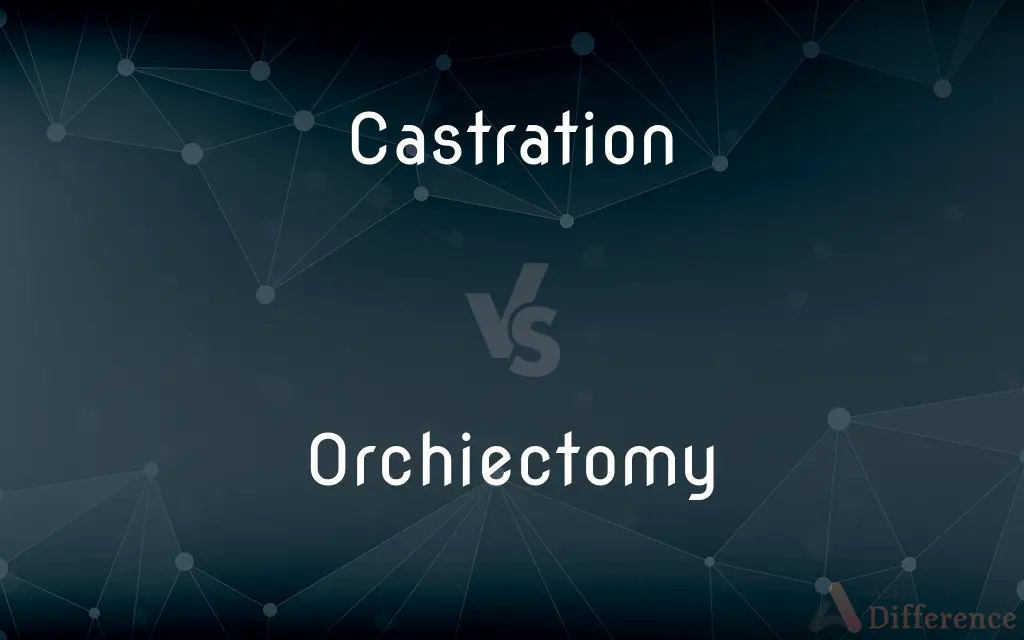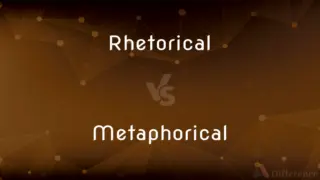Castration vs. Orchiectomy — What's the Difference?
By Tayyaba Rehman & Maham Liaqat — Updated on March 25, 2024
Castration is a broad term for removing the testes or ovaries, while orchiectomy specifically refers to the surgical removal of the testicles.

Difference Between Castration and Orchiectomy
Table of Contents
ADVERTISEMENT
Key Differences
Castration encompasses both the surgical and non-surgical removal of the gonads (testes in males and ovaries in females), leading to sterility and the cessation of certain hormone productions. Orchiectomy, on the other hand, is a surgical procedure strictly involving the removal of one or both testicles in males, often performed to treat testicular cancer or as part of gender reassignment surgery.
While castration can be achieved through various methods, including surgical, chemical, or hormonal treatments, orchiectomy is exclusively a surgical approach. Castration, as a broader term, can apply to both genders and to animals, affecting reproductive capabilities and hormonal balances. Orchiectomy, being a form of castration for males, specifically targets the physical removal of testicular tissue.
The implications of castration can vary widely depending on the method used and the individual's age and health. It historically had a range of uses, from punishment to the creation of eunuchs for specific social roles. Orchiectomy, particularly in the context of cancer treatment, focuses on removing a localized source of disease, with significant but more medically focused outcomes.
The effects of castration and orchiectomy on hormone levels are significant, as both procedures reduce testosterone production in males. However, the psychological and social impacts can differ greatly, with castration sometimes being associated with a broader cultural or historical context, whereas orchiectomy is typically discussed within a medical framework.
Comparison Chart
Definition
Removal of gonads, leading to sterility and hormone reduction.
Surgical removal of one or both testicles.
ADVERTISEMENT
Methods
Surgical, chemical, or hormonal.
Exclusively surgical.
Gender Application
Both males and females (testes or ovaries).
Males only.
Primary Purpose
Sterility, hormone reduction, sometimes punishment or control.
Treat diseases like cancer, part of gender reassignment.
Hormonal Impact
Reduces testosterone in males, estrogen in females.
Reduces testosterone production.
Historical Context
Broad use historically and culturally.
Medical procedure with specific purposes.
Psychological Impact
Varies widely, often significant.
Focused on medical treatment, with specific psychological impacts.
Compare with Definitions
Castration
Applies to both males and females.
In veterinary practice, castration is common for population control in animals.
Orchiectomy
Surgical removal of the testicles.
An orchiectomy is performed to treat testicular cancer.
Castration
Can be non-surgical, like chemical castration.
Chemical castration involves administering drugs to reduce hormone levels.
Orchiectomy
Can be unilateral or bilateral.
Bilateral orchiectomy involves the removal of both testicles.
Castration
Effects on hormone production.
Castration leads to a significant decrease in testosterone or estrogen.
Orchiectomy
A form of male castration.
Orchiectomy results in sterility and decreased hormone production.
Castration
The act of removing the reproductive organs.
Castration has been used for various purposes throughout history.
Orchiectomy
Medical procedure with specific outcomes.
The procedure aims to remove diseased tissue or reduce testosterone levels.
Castration
Historically used for different social roles.
Eunuchs were often castrated males serving in royal courts.
Orchiectomy
Part of gender reassignment surgery.
Orchiectomy is a step in the transition process for some transgender women.
Castration
Castration (also known as orchiectomy or orchidectomy) is any action, surgical, chemical, or otherwise, by which an individual loses use of the testicles: the male gonad. Surgical castration is bilateral orchiectomy (excision of both testicles), while chemical castration uses pharmaceutical drugs to deactivate the testes.
Orchiectomy
Orchiectomy (also named orchidectomy, and sometimes shortened as orchi or orchie) is a surgical procedure in which one or both testicles are removed. The surgery is performed as treatment for testicular cancer, as part of surgery for transgender women, as management for advanced prostate cancer, and to remove damaged testes after testicular torsion.
Castration
To remove the testicles of (a male); geld or emasculate.
Orchiectomy
Surgical removal of one or both testes.
Castration
To remove the ovaries of (a female); spay.
Orchiectomy
(surgery) The surgical removal of one or both testes.
Castration
To deprive of virility or spirit; emasculate.
Orchiectomy
Surgical removal of one or both testicles
Castration
An individual who is incapable of reproduction as a result of removal, destruction, or inactivation of the gonads.
Castration
(surgery) The act of removing the testicles.
Castration
(figuratively) Any act that removes power from a person (particularly a man) or entity.
Castration
The act of castrating.
Castration
Neutering a male animal by removing the testicles
Castration
The deletion of objectionable parts from a literary work
Common Curiosities
What are the main reasons for castration?
Reasons include sterility, hormone control, medical treatment, and historically, punishment or societal roles.
What is castration?
Castration refers to the removal of the gonads, rendering an individual sterile and affecting hormone levels.
Can castration be non-surgical?
Yes, castration can involve chemical or hormonal methods, not just surgical.
What is an orchiectomy?
Orchiectomy is the surgical removal of one or both testicles, primarily performed for medical reasons.
Can castration apply to animals?
Yes, castration is commonly performed on animals for population control, behavior management, and growth effects.
What is the difference between unilateral and bilateral orchiectomy?
Unilateral orchiectomy removes one testicle, while bilateral orchiectomy removes both.
Is orchiectomy performed on females?
No, orchiectomy is specifically the removal of testicles and therefore only applicable to males.
How does orchiectomy fit into gender reassignment?
It can be a step in the transition process for transgender women, helping align physical traits with gender identity.
Do both procedures affect hormone levels?
Yes, both significantly impact hormone levels, primarily testosterone in males.
Why would someone undergo an orchiectomy?
Common reasons include treating testicular cancer, as part of gender reassignment, or reducing testosterone levels.
What are the psychological effects of castration?
The effects can vary widely, from minimal with informed consent to significant, depending on the individual's situation.
How does orchiectomy affect testosterone levels?
It results in a substantial reduction in testosterone production.
What are the historical contexts of castration?
It has been used for various purposes, including punishment, slave trade, and creating servants or soldiers with specific characteristics.
Is castration reversible?
Surgical castration is permanent, while some forms of chemical castration are reversible.
Can orchiectomy be used to treat conditions other than cancer?
Yes, it can also be used to reduce testosterone levels for various medical reasons, including part of treatment for hormone-sensitive conditions.
Share Your Discovery

Previous Comparison
Performing vs. Performance
Next Comparison
Rhetorical vs. MetaphoricalAuthor Spotlight
Written by
Tayyaba RehmanTayyaba Rehman is a distinguished writer, currently serving as a primary contributor to askdifference.com. As a researcher in semantics and etymology, Tayyaba's passion for the complexity of languages and their distinctions has found a perfect home on the platform. Tayyaba delves into the intricacies of language, distinguishing between commonly confused words and phrases, thereby providing clarity for readers worldwide.
Co-written by
Maham Liaqat















































